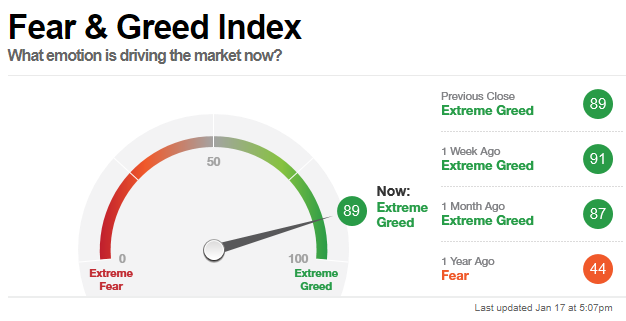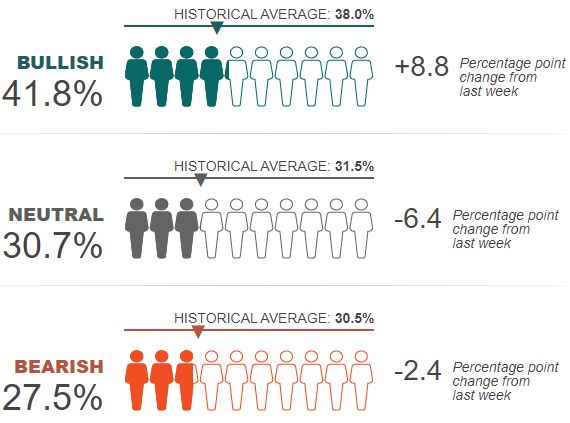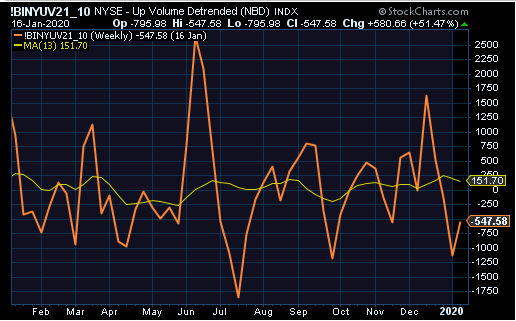What happened last week, and what it may mean for the market in 2020.
The Stock Market Report
The S&P 500 was up by 1.9% last week. How does that compare to all other weeks since 1950? Here are the numbers. (I only include up weeks in this summary)
- Median weekly gain since 2010 = 1.38%
- Median weekly gain since 2000 = 1.60%
- Median weekly gain since 1980 = 1.63%
- Median weekly gain since 1950 = 1.53%
It's always good to see an up week (if you're long, that is), and the 1.9% gain was well above the long-term average of 1.5% .
Investors today are optimistic about the market. We see this in surveys, articles, interviews, and financial media coverage. I'll show a few charts below that underscore this optimism.
Chart 1. The Fear & Greed Index
CNN Business publishes this chart. It shows that investors today are extremely greedy, and have been for the last few months. The indicators that feed into it are listed below the chart.
We look at 7 indicators:
•Stock Price Momentum: The S&P 500 (SPX) versus its 125-day moving average
•Stock Price Strength: The number of stocks hitting 52-week highs and lows on the New York Stock Exchange
•Stock Price Breadth: The volume of shares trading in stocks on the rise versus those declining.
•Put and Call Options: The put/call ratio, which compares the trading volume of bullish call options relative to the trading volume of bearish put options
•Junk Bond Demand: The spread between yields on investment grade bonds and junk bonds
•Market Volatility: The VIX, which measures volatility
•Safe Haven Demand: The difference in returns for stocks versus Treasuries
Chart 2. AAII Investor Survey
The American Association of Individual Investors publishes this graphic which is based on a frequent survey of their members. Bullish sentiment is up and Bearish is down, looking ahead for the market direction for the next 6 months. Their commentary is below.
"Bullish sentiment, expectations that stock prices will rise over the next six months, rebounded by 8.8 percentage points to 41.8%. Optimism is above its historical average of 38.0% for just the 12th time in the past 52 weeks.
Bearish sentiment, expectations that stock prices will fall over the next six months, pulled back by 2.4 percentage points to 27.5%. The drop keeps pessimism below its historical average of 30.5% for the 13th consecutive week."
For a one year chart of the AAII data, see this article.
Chart 3. Up Volume
The evidence is clear that the bulls are in control of this market. At some point they will become fully invested and will no longer be able to push the market higher. My last chart shows that we might be approaching that point.
This chart takes the up volume (for trades taking place at higher prices than the previous trade) and subtracts the trend, or average of all such trades. What we're left with is a visual representation of up volume, above or below its average.
The chart shows that, despite the string of new highs, and the bullish sentiment, and the fact that 80% of all stocks are trading above their 200 day moving averages, up volume is below trend. This tells me that the bulls might be running out of ammo. They are pushing the market higher, but on decreasing volume on up days.
Final Thoughts
Something has to give if this bull market wants to continue. Either the bulls must find a new source of ammo (available cash) or the bears have to give up and leave the market.
Over the past year or so, many high-profile bears have publicly announced that they were changing sides and becoming bulls. They too might be running out of ammo. What happens next?
When everyone is a buyer, and the few remaining sellers are hiding in their bunkers, you often get a blow-off top in the market. That's when gravity (our old friend mean-reversion) steps in and takes control.
Bears suddenly wake up and start selling again. Bulls buy the dips but they don't have enough cash to support the market. Selling begets more selling and the weaker players in the bullish camp begin to panic and start selling.
This isn't a pie-in-the-sky scenario. It's a replay of 2008, 2001, 1973, and so on. You had better be prepared because the day is coming. I don't know when, and I don't know how bad it will be, but I do know that it's coming.
My advice to bulls is to stay bullish and keep on buying the dips. But have a contingency plan in place just in case history repeats.
As always, if you like what you see, or have suggestions for improving this recap, leave a comment below, or email me at info@zeninvestor.org
Be sure to take advantage of our knowledge quizzes here.
And our free online courses here.



